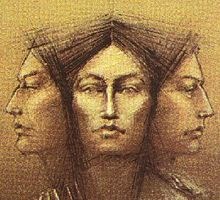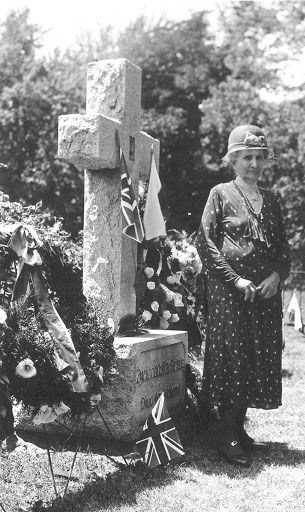
“Historians have historically been male and interested in what is deemed ‘masculine’ history: military, political, economic, etc. and these parts of history have been, until more recently, male dominated,” says Shawna Butts, assistant curator at the Niagara-on-the-Lake Museum.
“So, there is certainly a gender divide. This divide affects historians today because it only tells one gendered perspective of history.”
Butts believes that in addition to a gender divide there exists a racial divide in historical records.
She sought to help bridge that divide last week as the museum embraces the future to take a look at the past through its summer lecture series. On Thursday afternoon, Butts presented the next instalment of the series with her talk, Some Women of Niagara-on-the-Lake, via the Zoom platform, covering the contributions of five women who have had an influence on the lives, politics and welfare of local residents in their time and beyond.
The five women that were the topics of the lecture were Mary (Molly) Brant, Chloe Cooley, Mary Madden Henry, Mary Elizabeth Olivia Josephine Servos, and Elizabeth Ascher.
Following the lecture, Butts explains her motivation and her interest in women’s history “comes from the idea that history is only as complete as the voices it represents. These voices are women’s voices, but also, Black, Indigenous and people of colour’s voices as well. Many of these underrepresented histories have not been given justice in Niagara-on-the-Lake’s historical record.”
She began her lecture with Mary (Molly) Brant, also known by her Mohawk name Konwatsi’tsiaiénni, a well-respected Haudenosaunee leader within the Six Nations community. Born in 1736 in what is now upstate New York, she became a well-respected and powerful ally to the British during and after the American Revolution. After her husband Sir William Johnson’s death, a friend of his, Col. John Butler, asked Brant to use her influence to ease the increasing tensions between Indigenous people, who fled north to Fort Niagara, and the British occupying troops. She and her family stayed in the area for about two years, before settling around present day Kingston, Ontario with some land and pension provided for her service to the Crown.
“Although she is often overlooked because of her more famous brother Joseph Brant, or her husband Sir William Johnson, her achievements should not be ignored,” says Butts. “Mary was a very intelligent woman who was clearly at ease between these two cultures, and she was respected by the Six Nations and the Colonialists, which allowed her to use her influence on these two worlds at a vital moment in history.”
Then came the tragic story of Chloe Cooley, an enslaved Black woman who, on March 14, 1793, was beaten and bound by her owner, Sergeant Adam Vrooman, and transported across the Niagara River to America, where she was sold. Cooley’s resistance as she was forced into the boat was witnessed by a free Black man and former Butler’s Ranger, Peter Martin. Martin contacted another man, William Grisely, and the two brought the incident to the attention of Lieutenant Governor John Graves Simcoe. Simcoe set in motion legislation to abolish slavery, which began to lay the tracks for the Underground Railroad. Historical records on Cooley end with her sale, and as far as we know, she was never aware nor able to enjoy the benefits of legislation that her protest put in motion.
The third woman Butts would like us to remember is Mary Madden Henry. During the war of 1812, Henry’s husband, a former British soldier, was the local lighthouse keeper. On May 27, 1813, American forces invaded. There were heavy casualties. Henry went out into the battlefield to bring coffee and food to the soldiers and tend to the wounded. On Dec. 19, 1813, once again, Henry displayed bravery and compassion when she took in some of the townspeople and provided them with shelter, food and medical care after the Americans abandoned the fort and burned the town to the ground. Henry was recognized for her heroism after the war.
The fourth woman that Butts highlights is Mary Elizabeth Olivia Josephine Servos, the last person to own the Palatine Hills Homestead. She devoted her time to preserving the homestead and the museum her mother had created. Unfortunately, financial troubles during the Great Depression forced Servos to subdivide and sell off the property that had been in her family for five generations. She was then able to pay her back taxes and remain living on the homestead until her death on June 13, 1942 and is buried on the property.
During her life, she worked to promote and preserve her family’s legacy. Even though she planned the family’s treasures would remain in the family by bequeathing them to family members, the inheritors did not share her vision. Butts explains that the treasures eventually made their way to the NOTL Museum, to become “one of the most complete and unique collections from an Upper Canadian Loyalist.”
Eventually the homestead was abandoned, and in 1952 was burned to the ground in a Halloween prank, Butts says, imploring listeners to take a lesson from this story.
In a world that is developing rapidly, we need to remember that the preservation of our heritage matters. If we do not fight to preserve historic buildings and collections, then we effectively erase the stories of our past, and those who have come before us. Once gone, it is almost, if not impossible, to get back.”

The last woman on Butts’ list was Elizabeth Ascher, an educated and highly accomplished woman who left a lasting mark on the area. Among her accomplishments, she cofounded the Newark chapter of Independent Order of the Daughters of the Empire, was the Director of the Agricultural Society, and was on the executive of the Red Cross and the Boy Scouts.
On top of her charitable work, Ascher was also a newspaper reporter and wrote for the St. Catharines Standard, and the Niagara Advance.
She is best known, according to Butts, for her work with the Red Cross during the First World War. In September, 1917, Niagara was a training camp for Polish soldiers who were to fight on the Western front. In 1918, during the Spanish flu outbreak among the Polish soldiers stationed in Niagara, Ascher personally tended to them, putting her own life at risk, earning the nickname, Angel of Mercy. Ascher’s legacy began when she lobbied for a Polish cemetery at St. Vincent de Paul Church. In response, a Polish sovereign military burial plot was made for the soldiers who died in the influenza outbreak.
From 1919 to 1921, she used her voice as a reporter to launch a campaign to help the Polish people. Aid began to flow to Poland. For her efforts, Ascher received many awards, including The Medal of Haller and the Cross of Merit. She also was made an Honorary Colonel of the Polish Army and a Life Member of the Polish White Cross. Asher is still honoured to this day on the second Sunday of June at St. Vincent de Paul Church.
Butts says her interest was piqued by her participation in the museum’s upcoming publication about women of Niagara-on-the-Lake. “As community submissions came in for the publication, and I was reading them, I found that there were many women in NOTL history who I didn’t know about.”
Her interest also stems from her university courses in cultural anthropology at Guelph. “In several of our courses, we would talk about women’s roles in society, and we looked at how they differ across all cultures. While we focused a lot on more contemporary women’s issues, my interest in history always drove me to look at women in history.”
As for finding historic accounts of women’s contributions, Butts concedes, “it certainly can be difficult to research the history of a woman, but that doesn’t mean we shouldn’t try. There are records out there, if you know where to look. The first are church/municipal records like those for births, marriages and death. These types of records will help to trace the lineage of a woman’s family, including providing you with her legal name.”
Women in history are often referred to by their husband’s name, she says, “but a woman should not be defined by her status as a companion.”
For an example, she says, Elizabeth Simcoe, wife of John Graves Simcoe who played a role in the story of Chloe Cooley, was often afforded a certain status through her husband’s position. Butts points out Simcoe kept journals that “give us today an important glimpse into the early years of Upper Canada history and provide scholars (historians, environmentalists, artists, and more), an abundance of research material due to her detailed record of her life here.”
Another difficulty that also arises, says Butts, “is there are many families upon the death of an ancestor that throw away what could be fantastic archives, like letters, diaries, photographs and more, because they either don’t care, don’t think of local museums or don’t think that a museum would want these items. But we do. These personal mementos help us to tell someone’s story and allow us to preserve our history. They make great research documents, especially if written from a woman’s perspective.”
Butts believes it is important to celebrate of NOTL because “many of these women are courageous environmental and heritage activists, artists, heroes, politicians and professionals, and game changers. We acknowledge our male counterparts for their contributions to these fields, so why not do the same for women?”
Registration for the lectures is free, and if you miss the lecture or would like to enjoy it again, it will be uploaded on YouTube by the next day for public viewing. The link to this lecture on YouTube is https://youtu.be/xGbUwEcYidE.
Upcoming lectures include, on July 23, David Hemmings asking Was your grandmother a British Home Child? as he explores the history of the British Home Child system and its ties to NOTL. On July 30, Sarah Kaufman hosts a Q & A session online entitled Ask the Curator.
All presentations start at 4 p.m. and require registration through the Zoom platform. Contact Amy Klassen to register for the registration link to next week’s lecture at [email protected].
Correction: The woman in the photo published in the July 23 edition of The Local was not Chloe Cooley, as stated in the cutline. The Local apologizes for the error and any convenience it may have caused.